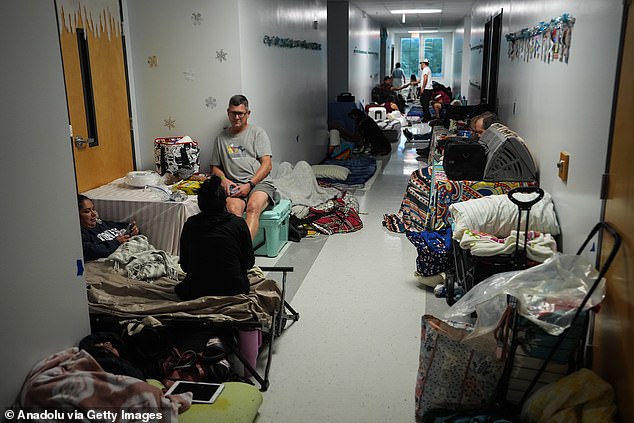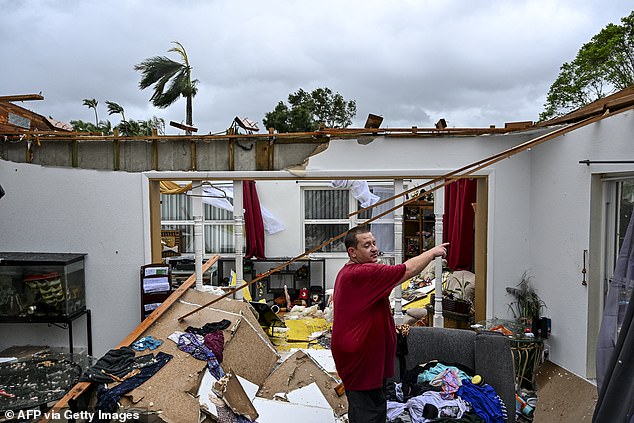Could Hurricane Milton stop Trump winning the election? Top pollster CRAIG KESHISHIAN reveals how devastation in these key Republican strongholds could radically re-shape the race
Nearly every modern American presidential election cycle is marred by some unforeseen “surprise.”
In July 1972, Democratic presidential candidate George McGovern was shocked to learn after his party’s summer convention that his running mate Thomas Eagleton had secretly received electroshock therapy to treat depression.
That was enough to discredit Eagleton among the big poohbahs of the Democratic Party and help doom McGovern’s campaign.
Eight years later, I was working as a strategist for Ronald Reagan’s 1980 presidential campaign, when my bosses coined the term “October Surprise.”
They were concerned that our opponent, President Jimmy Carter, would change the race by making a last-minute deal with armed Iranian revolutionaries to release the 53 American hostages who had been held in Tehran for more than a year.
Of course, everyone wanted the hostages to be released, regardless of the circumstances, but our job was to anticipate the possible political consequences of such an event.
Now, in 2024, we are back.
It’s early October, less than four weeks until the election, and another October surprise is in the works.
This one is not man-made. It is not the result of an unforced error by a candidate who behaves poorly.
It is an act of God that has consequences for the critical swing state of Florida.
It’s early October, less than four weeks until the election, and another October surprise is in the works.
First and foremost, I pray that everyone affected by Hurricane Milton emerges from this storm safe and free from property loss.
I also recognize that, tragically, this is an unlikely outcome. That’s why I offer this analysis as a political strategist and pollster, fully aware that many things in life are more important than elections.
But is it my job to think about what could happen – and I have come to the conclusion that Milton could be a game changer on November 5.
Let me explain:
In the 2020 election, Donald Trump defeated Joe Biden in Florida by more than 370,000 votes, which amounts to just 3 percentage points.
That’s a decent margin in the Sunshine State, but not a dominant one.
Trump won in 2020 in part by boosting Republican numbers in ruby-red GOP counties like Pasco, Marion and Sarasota, near Tampa.
Large turnouts in these Republican strongholds offset Democrats’ victories in blue parts of the state, such as Miami-Dade County in southeast Florida.
But now Hurricane Milton is blowing straight through the heart of Florida – and places like Pasco and Sarasota are right in its path.

(Above) Hundreds take shelter at Virgil Mills Elementary School ahead of Hurricane Milton, in Palmetto, Florida

(Above) Robert Haight looks around his destroyed home after it was hit by a reported tornado in Fort Myers, Florida on October 9, 2024
Of all fifteen Florida counties under mandatory evacuation orders, fourteen are overwhelmingly, if not overwhelmingly, Republican.
The total number of registered Republican voters in those fifteen counties is just over two million, while the number of registered Democrats in those same counties is approximately 1.2 million.
About 800,000 more registered Republicans than registered Democrats in the state of Florida are being told to leave their homes.
And that can have a huge impact.
In the 2020 election, Florida saw a turnout rate of a whopping 77 percent – meaning almost one in eight eligible voters cast a ballot.
What will it be in 2024?
Both Florida Democrats and Republicans in these Milton-affected areas will be under duress, hopefully not in life-threatening danger, but certainly so disadvantaged or inconvenienced that they may not vote.
For the sake of argument, consider what happens when disruption, financial loss, physical injury, or emotional distress reduces Florida’s voter turnout rate by up to 40 percent.
That is a realistic assumption. Who would bother to vote if their house had been blown off its foundation or their truck had been destroyed – or worse?
At that 40 percent suppressed rate, only 320,000 Republicans in these affected counties would show up or mail in their ballots on Election Day.
That’s an expected loss of 280,000 Republican votes.
Remember, Trump only won by 370,000.
In other words, these elections may have gotten much closer.
And now add to these calculations the additional motivating factors driving Florida Democrats to the polls.
There’s a measure on the ballot that would enshrine the right to abortion in the Florida Constitution — and another would legalize recreational marijuana.
Many of my fellow Republican strategists underestimated the electoral impact of abortion measures on the vote in the 2020 midterm elections – predicting a “red wave” for the Republican Party across the country.
I thought differently about that and said so on national television at the time.
Indeed, the ‘Red Wave’ never materialized.
There is reason for Donald Trump’s campaign to be concerned.
Florida Governor Ron DeSantis is an honorable man, and he understands that his primary job is to protect people and property in his state.
But I hope the governor’s office, among many initiatives in the coming days, also considers how this storm could disenfranchise voters.
Perhaps the governor could relax absentee voting rules, or better yet, attach an absentee ballot measure — Democratic and Republican — to any relief package his Office of Emergency Management hands out.
By doing so, the governor will fulfill his obligations to protect both life and democracy.
No race should be won because Americans couldn’t vote.
Craig Keshishian was project director for President Reagan’s polling agency and later worked at Reagan’s Presidential Speechwriting and Research Office
